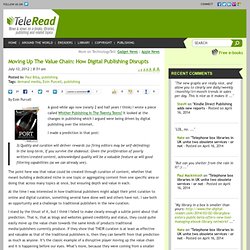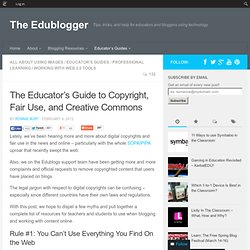

Moving Up The Value Chain: How Digital Publishing Disrupts. By Eoin Purcell A good while ago now (nearly 2 and half years I think) I wrote a piece called Whither Publishing In The Twenty Teens?

It looked at the changes in publishing which I argued were being driven by digital publishing over the internet. I made a prediction in that post: 3) Quality and curation will deliver rewards (so firing editors may be self-defeating) in the long-term, if you survive the shakeout. Given the proliferation of poorly written/created content, acknowledged quality will be a valuable feature as will good filtering capabilities (as we can already see).
The point here was that value could be created through curation of content, whether that meant building a dedicated niche in one topic or aggregating content from one specific area or doing that across many topics at once, but ensuring depth and value in each. I stand by the thrust of it, but I think I failed to make clearly enough a subtle point about that prediction. Here’s how Jeremy Reed discussed their new effort: Self Publishing. After creating your user profile, the second step is to upload your ebook.

To give you an idea of the various options available to you, let’s start from the type of file you have: - Do you have an EPUB file? Great! Then you are on the verge of publication: you can upload the file into your private area and in a few hours your ebook will be on sale in all the stores connected to us, including Amazon, Apple, Kobo and Barnes & Noble! Be careful, though: make sure that your file has passed the epubcheck validation. - Do you have a PDF file? - Do you have a .doc file? To create your EPUB file, you have two possibilities: 1) you can use our free tool called BackTypo, an online application that allows you to create your own EPUB files which are already validated and technically ready for publication; 2) alternatively, we can handle the conversion at a cost of €0.60 per standard page. The Educator’s Guide to Copyright, Fair Use, and Creative Commons. Lately, we’ve been hearing more and more about digital copyrights and fair use in the news and online – particularly with the whole SOPA/PIPA uproar that recently swept the web.

Also, we on the Edublogs support team have been getting more and more complaints and official requests to remove copyrighted content that users have placed on blogs. The legal jargon with respect to digital copyrights can be confusing – especially since different countries have their own laws and regulations. With this post, we hope to dispel a few myths and pull together a complete list of resources for teachers and students to use when blogging and working with content online.
Rule #1: You Can’t Use Everything You Find On the Web Dexter the cat hates those that steal his photos… This may seem obvious, but judging by the notices we have received, many teachers (and especially students) are under the impression that if it is on the web, then it is up for grabs. Rule #2: There Are Resources You CAN Use Images Videos.